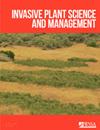Effectiveness and cost of a rapid response campaign against Japanese knotweed (Reynoutria japonica) along a Canadian river
IF 1.2
4区 生物学
Q3 PLANT SCIENCES
引用次数: 0
Abstract
Abstract Japanese knotweed (Reynoutria japonica Houtt.) is an invasive Asian plant abundant along rivers in its introduced range. In riparian areas, floods and ice flows uproot the rhizomes, facilitating their dissemination downstream. Control of large, well-established R. japonica clones in riparian areas is difficult if the use of herbicides is prohibited. An alternative to controlling entrenched clones is the rapid detection and manual unearthing of rhizome fragments that have recently rooted after being deposited by floodwaters. We applied this strategy along a Canadian river where spring floods with abundant ice are recurrent. Two river stretches, with approximately 10 km of shoreline each, were selected for the fragment removal campaign. One of the stretches was heavily invaded by R. japonica, while the other was only sparsely invaded. In the heavily invaded stretch, 1,550 and 737 R. japonica rhizome fragments were unearthed in 2019 and 2020, respectively. Unearthed fragments had an average length of 27 to 32 cm. Only 21 fragments were found in the sparsely invaded stretch in 2020. Despite similar distances being surveyed, the detection and unearthing took 62% less time (overall) in the sparsely invaded than in the heavily invaded stretch. Along sparsely invaded riverbanks, a rapid response removal campaign for R. japonica cost, including transportation and labor, an estimated Can$142 (US$105) per aborted clone (i.e., fragment removed). A rapid response removal campaign is economically advantageous compared with the hypothetical eradication of large, well-established clones, but for it to be cost-effective, the time spent locating rhizome fragments must exceed the time spent unearthing them. The question is not whether rapid response unearthing is economically feasible—it is—but rather what invasion level renders the intervention practicable. In highly invaded river stretches generating thousands of fragments annually, finding and removing these fragments year after year would require a massive, unsustainable effort.加拿大河流沿岸针对日本knotweed(Reynoutria japonica)的快速反应行动的有效性和成本
摘要日本knotweed(Reunoutria japonica Houtt.)是一种亚洲入侵植物,在其引种范围内沿河流大量分布。在河岸地区,洪水和冰流将根茎连根拔起,促进其向下游传播。如果禁止使用除草剂,在河岸地区控制大型、成熟的R.japonica无性系是困难的。控制根深蒂固的无性系的另一种选择是快速检测和手动挖掘最近被洪水沉积后生根的根茎碎片。我们在加拿大的一条河流上应用了这一策略,那里经常发生春季洪水和大量的冰。碎片清除活动选择了两条河段,每条河段的海岸线约为10公里。其中一个河段受到了R.japonica的严重入侵,而另一个河段则受到了稀疏的入侵。在入侵严重的河段,2019年和2020年分别出土了1550块和737块粳稻根茎碎片。出土的碎片平均长度为27至32厘米。2020年,在人烟稀少的地区只发现了21块碎片。尽管调查的距离相似,但在入侵稀少的地区,探测和挖掘所花费的时间(总体上)比入侵严重的地区少62%。沿着人烟稀少的河岸,一场快速反应的日本血吸虫清除行动的成本,包括运输和劳动力,估计每个流产的克隆(即去除的片段)要142加元(105美元)。与假设根除大型、成熟的无性系相比,快速反应清除运动在经济上是有利的,但为了具有成本效益,定位根茎碎片所花费的时间必须超过挖掘根茎碎片所花的时间。问题不在于快速反应挖掘在经济上是否可行——确实可行——而在于入侵程度如何使干预可行。在每年产生数千块碎片的高度入侵的河段,年复一年地寻找和清除这些碎片需要付出巨大而不可持续的努力。
本文章由计算机程序翻译,如有差异,请以英文原文为准。
求助全文
约1分钟内获得全文
求助全文
来源期刊

Invasive Plant Science and Management
PLANT SCIENCES-
CiteScore
2.20
自引率
9.10%
发文量
24
审稿时长
6-12 weeks
期刊介绍:
Invasive Plant Science and Management (IPSM) is an online peer-reviewed journal focusing on fundamental and applied research on invasive plant biology, ecology, management, and restoration of invaded non-crop areas, and on other aspects relevant to invasive species, including educational activities and policy issues. Topics include the biology and ecology of invasive plants in rangeland, prairie, pasture, wildland, forestry, riparian, wetland, aquatic, recreational, rights-of-ways, and other non-crop (parks, preserves, natural areas) settings; genetics of invasive plants; social, ecological, and economic impacts of invasive plants and their management; design, efficacy, and integration of control tools; land restoration and rehabilitation; effects of management on soil, air, water, and wildlife; education, extension, and outreach methods and resources; technology and product reports; mapping and remote sensing, inventory and monitoring; technology transfer tools; case study reports; and regulatory issues.
 求助内容:
求助内容: 应助结果提醒方式:
应助结果提醒方式:


